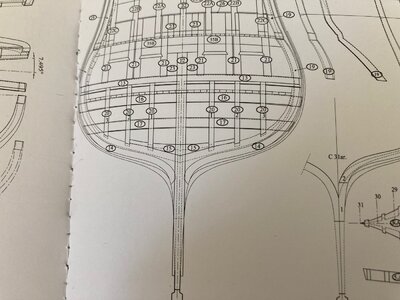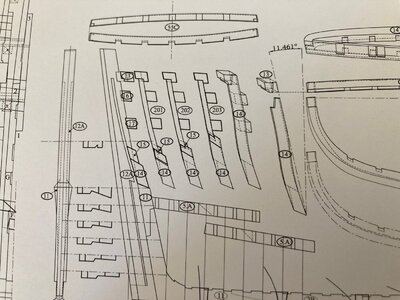You are using an out of date browser. It may not display this or other websites correctly.
You should upgrade or use an alternative browser.
You should upgrade or use an alternative browser.
Hi bandido
Interesting question.Personally I think it is because if you ran the planking horizontally you would end up with several narrow planks tapering to nothing when you get to the curve around the bottom of the transom.Angling the planks in this area prevents that.
Kind Regards
Nigel
Interesting question.Personally I think it is because if you ran the planking horizontally you would end up with several narrow planks tapering to nothing when you get to the curve around the bottom of the transom.Angling the planks in this area prevents that.
Kind Regards
Nigel
I agree with Nigel
Take a look at these sterns, which makes the problem at the lowest point visible
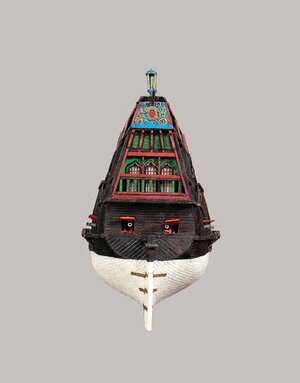
The biggest problem here was to get the watertightness at the edges of the construction
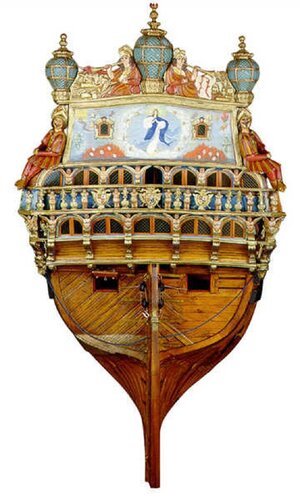
sketches taken from the informative web-page
Take a look at these sterns, which makes the problem at the lowest point visible

The biggest problem here was to get the watertightness at the edges of the construction

sketches taken from the informative web-page
Bertan 23 - Our boats Chapter 14: The galleon. Sixteenth - Seventeenth centuries
bertan.gipuzkoakultura.net
- Joined
- Dec 1, 2016
- Messages
- 5,136
- Points
- 728

maybe this is why
lower transoms are run horizontally so if you run the planking in the same direction, you will get long seams that are not backed up with anything. Like the blue arrows maybe you might get a seam that falls on a transom like the green arrow.
Another problem with horizontal planking is the face of the transoms are not flat they bevel so a tight seam is difficult.
if you run the planking on an angle first you can bend a plank to the beveled face of the transom and if the transoms are placed close together you can nail along the edge of each plank and into the transom.
the upper part is the stern timbers and they run vertical so the planking would run horizonal
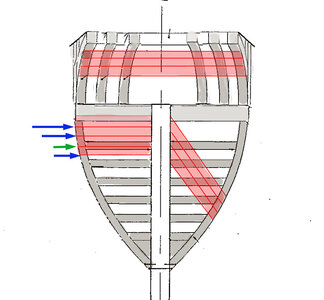
lower transoms are run horizontally so if you run the planking in the same direction, you will get long seams that are not backed up with anything. Like the blue arrows maybe you might get a seam that falls on a transom like the green arrow.
Another problem with horizontal planking is the face of the transoms are not flat they bevel so a tight seam is difficult.
if you run the planking on an angle first you can bend a plank to the beveled face of the transom and if the transoms are placed close together you can nail along the edge of each plank and into the transom.
the upper part is the stern timbers and they run vertical so the planking would run horizonal

- Joined
- Jan 21, 2022
- Messages
- 397
- Points
- 238

Thanks for the info makes sensemaybe this is why
lower transoms are run horizontally so if you run the planking in the same direction, you will get long seams that are not backed up with anything. Like the blue arrows maybe you might get a seam that falls on a transom like the green arrow.
Another problem with horizontal planking is the face of the transoms are not flat they bevel so a tight seam is difficult.
if you run the planking on an angle first you can bend a plank to the beveled face of the transom and if the transoms are placed close together you can nail along the edge of each plank and into the transom.
the upper part is the stern timbers and they run vertical so the planking would run horizonal
View attachment 301087
Dave, I agree with your reasoning, however French Men of war of the 17th Century prior to adopting a round tuck stern had vertical timbers supporting the transom planking.These timbers were then fastened to the horizontal timbers.Later, when the French adopted a round tuck then the planks were nailed direct to the horizontal timbers.
Regards
Nigel
Regards
Nigel
- Joined
- Dec 1, 2016
- Messages
- 5,136
- Points
- 728

Dave, I agree with your reasoning, however French Men of war of the 17th Century prior to adopting a round tuck stern had vertical timbers supporting the transom planking.These timbers were then fastened to the horizontal timbers.Later, when the French adopted a round tuck then the planks were nailed direct to the horizontal timbers.
Regards
Nigel
that has been a problem in this hobby for years builders take a fact or building method and apply it to all ships over all time.
Your right the French did not build ships like the British and Americans and Dutch ship building is different. Over time methods evolved.
What i suggested is one possibility is many different types of sterns and construction methods.
Do you have some sort of sketch or image showing the method you described?
- Joined
- Dec 1, 2016
- Messages
- 5,136
- Points
- 728

thanks for the post
- Joined
- Apr 30, 2018
- Messages
- 105
- Points
- 88

Hmm, just wondering if the diagonal planks also might have helped to support the transom and poop/quarterdeck timbers since they are fastened to the last hull frame and run diagonally? They might have helped since the sterns and bows, being the weaker sections of hulls, hogged so quickly.


